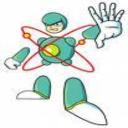Yahoo Answers is shutting down on May 4th, 2021 (Eastern Time) and beginning April 20th, 2021 (Eastern Time) the Yahoo Answers website will be in read-only mode. There will be no changes to other Yahoo properties or services, or your Yahoo account. You can find more information about the Yahoo Answers shutdown and how to download your data on this help page.
Trending News
Physics questions regarding table and force?
A table is built of two legs, A and B, and a rod of mass-10 kg and length 5m. A small block of 2 kg is placed on the bridge 0,75 m from leg B. Both the rod and the blocks have constant densities(are uniform). You may assume that the legs are very narrow compared to the length of the rod. Find the force with which each leg supports the rod and the block
2 Answers
- electron1Lv 77 years ago
The sum of the forces which the legs support is equal to the sum of the weights. Let’s determine the weight of the rod and block.
Rod = 10 * 9.8 = 98 N, Block = 2 * 9.8 = 19.6 N
Total weight = 117.6 N
Fa + Fb = 117.6
The clockwise torque is equal to the counter clockwise torque. Let the pivot point be at A. The weight of the rod and the weight of the block produce clockwise torque. The upward force at B produces counter clockwise torque.
Torque = Force * distance from the pivot point
The weight of the rod is 2.5 meters from A.
Clockwise torque = 98 * 2.5 = 245
The weight of the block is 4.25 meters from A.
Clockwise torque = 19.6 * 4.25 = 83.3
Total clockwise torque = 328.3
The upward force at B is 5 meters from A.
Clockwise torque = Fb * 5
Fb * 5 = 328.3
Fb = 65.66 N
Fa = 117.6 – 65.66 = 51.94 N
- civil_av8rLv 77 years ago
FBD of the problem
Na ............. ..... Wr ........ Wb ........... Nb
↑ ....... ........ ......↓ ......... ...↓ ........ ......↑
A________ cg-rod ____ block _______ B
|----- ----------- 5m ------------- ------------|
|------- 2.5 m ---- |
| ------------ 4.25 m --------- | - 0.75 m --|
Note: The CG of the rod is 1/2 the length.
Sum of the moments about A = 0 <---- No rotation and CCW = +
0 = Nb*5m - Wr*2.5m - Wb*4.25 m
Nb = (Wr*2.5 m + Wb*4.25m) / 5m
Nb = (10 kg * 9.81 m/s^2 * 2.5 m + 2 kg * 9.81 m/s^2 * 4.25 m) / 5 m
Nb = 65.7 N
Sum of the forces in the vertical direction = 0 <----- No acceleration and up is positive
0 = Na + Nb - Wr - Wb
Na = Wr + Wb - Nb
Na = 10kg * 9.81 m/s^2 + 2kg * 9.81 m/s^2 - 65.7 N
Na = 52.0 N


